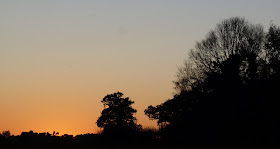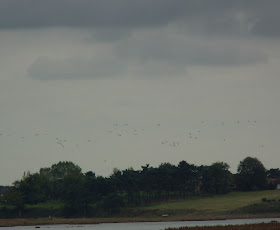Caroline Gill's Wildlife Record: Suffolk Horizons (and the World beyond her Window)
Monday, 14 November 2011
Marshland Habitat (2): From Dead Wood to Dunlin
We are greatly enjoying our exploration expeditions in Suffolk. The light was fading fast as we set off, but we were delighted to see so many Dunlin (albeit at some distance) out on the mere. I have never knowingly watched these birds before. Another first for me.
As I have mentioned in a previous post, the reedbed landscape is usually only punctuated by sails or church towers, windmills or ... dead trees.
These 'corpses' are apparently not the result of disease or strikes by lightning. Rather, they are reminders of the time when the old fields were flooded.
Particularly high tides breached the bank in this area near Snape back in 1953, creating a large area of mudflats. In days gone by, the barge sailors referred to one of the wide stretches of the river Alde as 'Troublesome Reach'. It is still possible to see withies - long wooden stakes used as markers - standing proud from the river bed, to guide the vessels along the deeper channels.
We saw most of our birds out on the water, but there were one or two rustles in the leaves overhead. This Great Tit was pretty camouflaged in the sunlit mosaic of turning autumn leaves.
We seem to have seen more Ladybirds than ever before this year. There were one or two Seven-spotted ones (Coccinella septempunctata) on the stinging nettles.
Saturday, 12 November 2011
Seasonal Splash (3): Winter Colour ... and Windmills
 |
| Autumn colour at Framlingham ... a sign of things to come |
We passed Saxtead Green Post Mill, dating from 1796. It ceased working commercially in 1947.
 |
| Aldeburgh Old Mill |
We were at Aldeburgh for the Poetry Festival last weekend, where we saw another mill (above, right), straddling the high(er) ground between the shore and the marshland around the Alde estuary. I shall have to find out more about these buildings.
P.S. It seems we are not the only ones to be seeing Ladybirds ...
Monday, 31 October 2011
Beautiful Birds (29): Orford and Havergate
The striped lighthouse is at Orford Ness, a National Nature Reserve in the care of the National Trust off the Suffolk coast. The area is a particularly important breeding ground for the Little Tern (Sterna albifrons). There is also a Gull colony. We parked at Orford last Saturday afternoon, and took a blustery walk along the shoreline ...
... passing lots of boats ...
We were particularly interested to discover that Suffolk's only island, Havergate, is just a short boat ride away. The island is protected by the RSPB - and noted for its Avocets (such magnificent birds!), waders, ducks and Brown Hares.
- Orford Ness (and Sutton Hoo) in the East Anglian Daily Times
Saturday, 29 October 2011
Eye-catching Insects (7): Ladybird
 |
We went out in the autumn sunshine to photograph one of the round-towered Suffolk churches, Hasketon. While we were there, we noticed a flurry - or should I say a 'loveliness'? - of Ladybirds by the lychgate. For the most part, they were very active and therefore not easy to catch on camera.
 |
| The village sign |
 |
| This photo shows the Seven-spotted Ladybird (Coccinella septempunctata) perched on an ivy bush. |
The beautiful church, incidentally, is dedicated to St Andrew. The round Norman tower was re-worked c.1300. There is fine flint-work visible on the exterior.
Wednesday, 26 October 2011
Beautiful Birds (31): Black Swans ... and Flamingo update
I spotted these Black Swans (Cygnus atratus) at Snape some days ago, just as the light was fading. As a breed, they come from Australia. You can read more about them here on the RSPB site.
The RSPB South Suffolk Tweet for 21 October mentions that there was still a Flamingo around in the county [ #havergate].
These three (above) were not seen in Suffolk, but I thought they would add a bit of colour!
These three (above) were not seen in Suffolk, but I thought they would add a bit of colour!
Saturday, 22 October 2011
Beautiful Birds (30): RSPB Reserve Minsmere, Suffolk, UK
 |
| A Teal (not a Shoveler) ... shovelling! |
 |
| David lining up the camera for a waterfowl fly-past |
 |
| You can see the Mismere RSPB Reserve on the left and the North Sea on the right ... pretty chilly, too! |
 |
| And here they come! |
 |
| A Little Egret surrounded by a group of Teal, with their heads below the surface. |
 |
| Is this a Bar-Tailed Godwit? No, I gather it's a Black-Tailed one. |
 |
| We drove past the RSPB Deer Rut station ... into the Dunwich sunset. |
Friday, 21 October 2011
Tuesday, 18 October 2011
Beautiful Birds (29): Starlings at Felixstowe
 |
| This Starling (and presumably its shadow) had a ring on its right leg. |
 |
| It was dining off pizza ... and probably chips. |
 |
| The container port near Landguard Point seemed to be home to a large number of Starlings ... |
 |
| ... though on this occasion, I only caught a few on camera, as they prepared for take-off. |
Monday, 17 October 2011
Marshland Habitats (2): Roost at Snape Maltings, Suffolk, UK
 |
| The twilight roost begins as different species gather in flocks ... |
 |
| ... and daylight fades. |
 |
| Starlings gather on the roof at Snape Maltings ... |
 |
| ... taking to the skies ... |
 |
| ... in an ever-changing swarm ... |
 |
| ... until all is still once more. |
Friday, 14 October 2011
Marshland Habitats (1): Snape, Suffolk, UK
 |
| David at Snape, first visit for about 20 years |
The landscape known as Snape Marshes is managed by the Suffolk Wildlife Trust. The area constitutes a wonderful wetland habitat, bounded by the River Alde in Suffolk.
I spent my teenage years in a village some five miles out of Norwich, close to the home of Norfolk naturalist, Ted Ellis. The marshland at Snape reminded me of Sunday walks on Surlingham Church Marsh, weaving in and out of the reed beds, keeping alert in case a Swallowtail butterfly or a non-native Coypu came into view.
There is something very special about reeds. They sway with the wind and emit a unique fragrance all of their own. There were some workers 'slubbing' (clearing the silted sections of dyke, in a sequence of rotation) with machinery while we were there to ensure that the habitat remains suited to creatures like the Otter.
We ambled out along the track, and turned to look back at Snape Maltings, now a music hall complex with shops and cafes.
If we were fooled by this gallant steed, it was only for a moment ... honest!
What a glorious site! I felt it could be straight out of a Cotman painting. The Thames barge from Harwich wove its way gently and gracefully through the narrow channels.
Suddenly there was a flicker overhead, as a Marsh Harrier (and here) began to hover.
We had seen the best of the daylight, but dusk brings its own rewards - and we THINK this may be a flock of Avocets (and here). I have enlarged and lightened a section of the photograph below in case any of you out there can confirm or refute our attempt at identification!
What an exciting initial foray into the 'wilds' of the beautiful Suffolk countryside.
 |
| Compare with the banner photo here: are these Avocets, I wonder? |
Saturday, 6 August 2011
Eye-catching Insects (5): Summer Isles Insect
While we were in the north of Scotland, we took an afternoon cruise to the lovely Summer Isles, off Achiltibuie, some way north of Ullapool. It was a very calm, mild but somewhat grey day as we set off, but much to our delight, the sun came out and the intense metallic blues of the ocean were a sight to behold.
Our vessel took us around the island of Tanera Mor, before we landed for a little exploration and some refreshments. The insect life was amazing, and this iridescent green beetle caught my eye. It wasn't going to hang around, so I only managed two photos - and the other was rather fuzzy! The picture below is a cropped close-up to aid identification.
I really hadn't paid much heed to the spots on the creatures back, but having Googled away, I am wondering whether they may be more significant than I had realised. I am wondering whether this could be a species of Green Tiger Beetle, though perhaps 'Leopard Beetle' would be more appropriate since these are definitely spots and not stripes!
The Essex Field Club have announced that Jerry Bowdrey is researching the distribution of this insect in their part of the world. My identification may not be correct, but I would be grateful - out of interest - if anyone was able to let me know. I gather from Buglife that there are 5 species in Britain.
I thought you would like this photo below of some of the other Summer Islanders!
- Green Tiger Beetle on Buglife
- and on ARKive
- Tanera Mor - 'Making Scotland's Landscape' with BBC presenter, Iain Stewart
Thursday, 4 August 2011
Seals, Sharks and Cetaceans (3): Bottlenose Dolphins in the Moray Firth
 | |
| A satisfied dolphin-watcher (me!) |
The photo above has been included to show how narrow the strait is at this point - and to show just how close to the shore the dolphins were happy to come.
One minute there was a tail flip ...
... and then a back flip.
Sometimes it was hard to tell whether we were watching one dolphin or two.
There is something very serene and submarine-like about these creatures!
It was difficult to predict where the dolphins would surface, in terms of having the camera poised, so this is a rare facial picture.
... and so is this. Could it be a mother and calf?
There certainly seem to be two dolphins here.
I am fascinated by the four tiny peaks of water on the left hand side.
Mother and calf swimming off in tandem ...
The Moray Firth is a great place to watch dolphins because they come so close to the shore. There are boat trips for those who prefer to watch from the water. Dolphins, of course, are wild creatures and come and go as they please. They are not always around, but we have watched from this spot (with binoculars, camera and monopod to hand) on several occasions now, and have been very lucky. These are apparently the most northerly Bottlenose Dolphins in the world, and we feel very privileged to have shared in these moments of their lives.
































